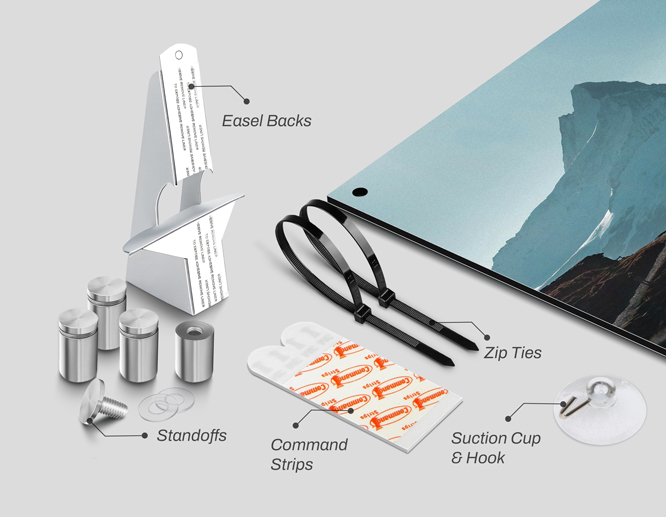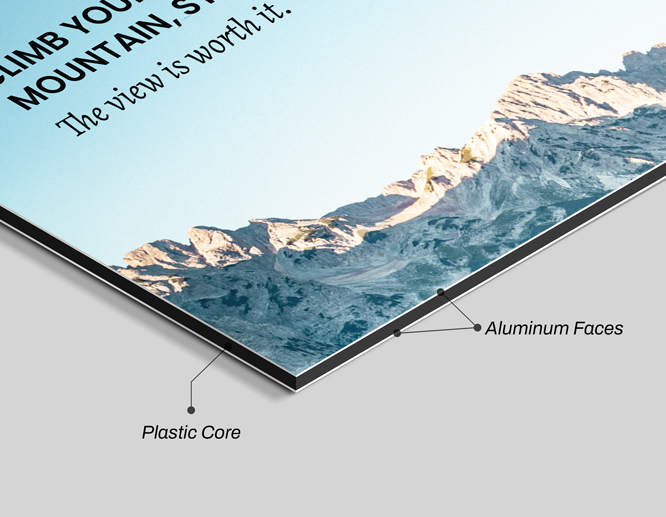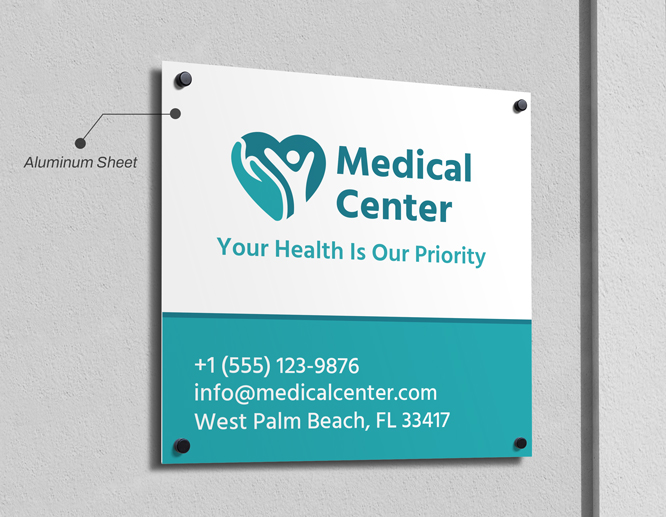Choosing between dibond and aluminum may be confusing, and customers want to know the difference between them before making a purchase. When you know the main features that set them apart, you’ll choose the material that better resonates with the project at hand. This article will highlight the main differences between aluminum and dibond signs and help you decide which one suits your needs.
Key Takeaways
- Dibond has a composite structure, while aluminum is a single solid sheet.
- Dibond is more durable with superior weather resistance; aluminum is also long-lasting, rust-resistant, and weatherproof.
- Dibond is ideal for high-quality printing and works well for larger signs; aluminum provides good customization, a professional look, and various finish options.
- Aluminum is lighter and easier to install; dibond's rigidity requires more care for large sizes.
- Aluminum is more budget-friendly; dibond is pricier but offers premium quality for high-visibility needs.
Dibond Signs
Dibond signs are popular within the printing industry thanks to their high quality, durability, and ability to drive sales. It’s an aluminum composite which combines two pre-painted aluminum sheets enclosing a solid polyethylene core.
They are, without a doubt, an excellent signage option for both outdoor and indoor use. Dibond signs create a modern industrial appeal and retain their integrity without being altered by weather fluctuations. Businesses also use them for interior design or to complete a signature look inside.
Aluminum Signs
Aluminum signs are a solid choice when you’re looking for a more traditional metal feel. They’re made of aluminum substrates with a white coating, ready to be printed with any design and color. Constructed using a single sheet, aluminum signs are lightweight and highly versatile.
Aluminum signs make it clear to visitors that your company is professional and cares about its image. These signs promise to last much longer than other types of materials in a nod to their durability.
Dibond vs Aluminum Signs
Dibond and aluminum signs are both great choices for outdoor and indoor use. Still, there are some key differences between dibond and aluminum signs you’d best keep in mind when choosing your material.
Material
Have a look at metal signs vs dibond comparison from their material’s perspective. Aluminum signs are made of robust panels that are coated with a durable finish to protect them from harsh elements. The material used for dibond signs consists of a lightweight plastic core encased in aluminum on both sides.
Durability
Aluminum signs boast a long lifespan, even when used outdoors. Thanks to UV printing technologies, they resist rain, UV exposure, and temperature changes. Dibond signs are also a great choice for businesses looking for durable sign options. Their composite structure offers additional protection against weather conditions and helps them resist rust and corrosion.
Customization
The design flexibility of the material is essential when it comes to creating custom business signs. Both aluminum and dibond are perfect for creating outstanding designs that turn heads.
Aluminum is a classic and traditional option, suitable for various professional applications. Businesses can print and design aluminum signs in several shapes, ironing out the tiniest of details to ensure optimal clarity.
With dibond, businesses move beyond standard customization. While dibond and aluminum signs share the same ultra-smooth surface, dibond's unique core structure sets it apart. This core makes dibond slightly thicker to work better for larger sign projects without the need for additional support.
Resistance to Weather Conditions
One of the differences between aluminum and dibond signs is their weather resistance features. Aluminum signs are made for the outdoors (as well as indoors). This means rain, humidity, and changing temperatures won’t cause them to bend or warp over time.
Dibond signs offer added resilience thanks to their layered compositions. They tolerate weather shifts easily and maintain structural integrity under sun exposure. Dibond signs’ core is water-resistant, which prevents water damage.
Both aluminum and dibond signs excel in weather resistance. Aluminum withstands rain, humidity, and temperature changes without warping. Dibond's water-resistant layered core provides added resilience against weather shifts and sun exposure.
Installation
Dibond and aluminum signs have many installation options, most of which are common for both. The installation processes may vary depending on the sign size and design. Aluminum signs are relatively easy to install due to their light weight. They can be mounted on various surfaces.
Dibond signs, while also not overly complex to install, have a more rigid structure; therefore, they may require a bit more care. The same installation options are available for Dibond sign mounting, with extra help needed for larger sizes.
The most common setup options for these two signs include standoffs, command strips, zip ties, easel backs, and suction cups and hooks.

Cost
Cost is often a deciding factor when selecting the right sign for your business, and this holds true in the aluminum dibond vs metal prints cost comparison. Aluminum signs are generally more cost-effective than dibond signs. This is particularly true for standard designs and sizes. Specific customization options can increase the price, which can include unique shapes, colors, or added finishes.
Dibond signs, on the other hand, are prone to being more expensive as they have a composite structure and superior printing customization options. Factors such as size, design complexity, and the printing process used may drive up the cost.
However, both signs are a wise long-term investment for businesses.
How to Choose Between Dibond and Aluminum Signs
You can't go wrong with either material, as they are both professional and durable. Aluminum offers outstanding value for most applications, like directional signage, office and lobby signage, and general informational displays.
Dibond provides enhanced resilience and a premium look when you need that extra level of quality. Its superior flatness makes it ideal for high-volume uses such as upscale retail storefronts, large-scale exterior graphics, and executive boardroom displays.
Consider your specific needs, environment, and budget when you make a choice between dibond and aluminum signs. For standard outdoor signs in typical conditions with moderate budgets, aluminum is your reliable workhorse. For high-visibility, long-term installations where appearance and extreme durability matter most, dibond is worth the investment.
If you’re still unsure, contact our specialists for more information.



